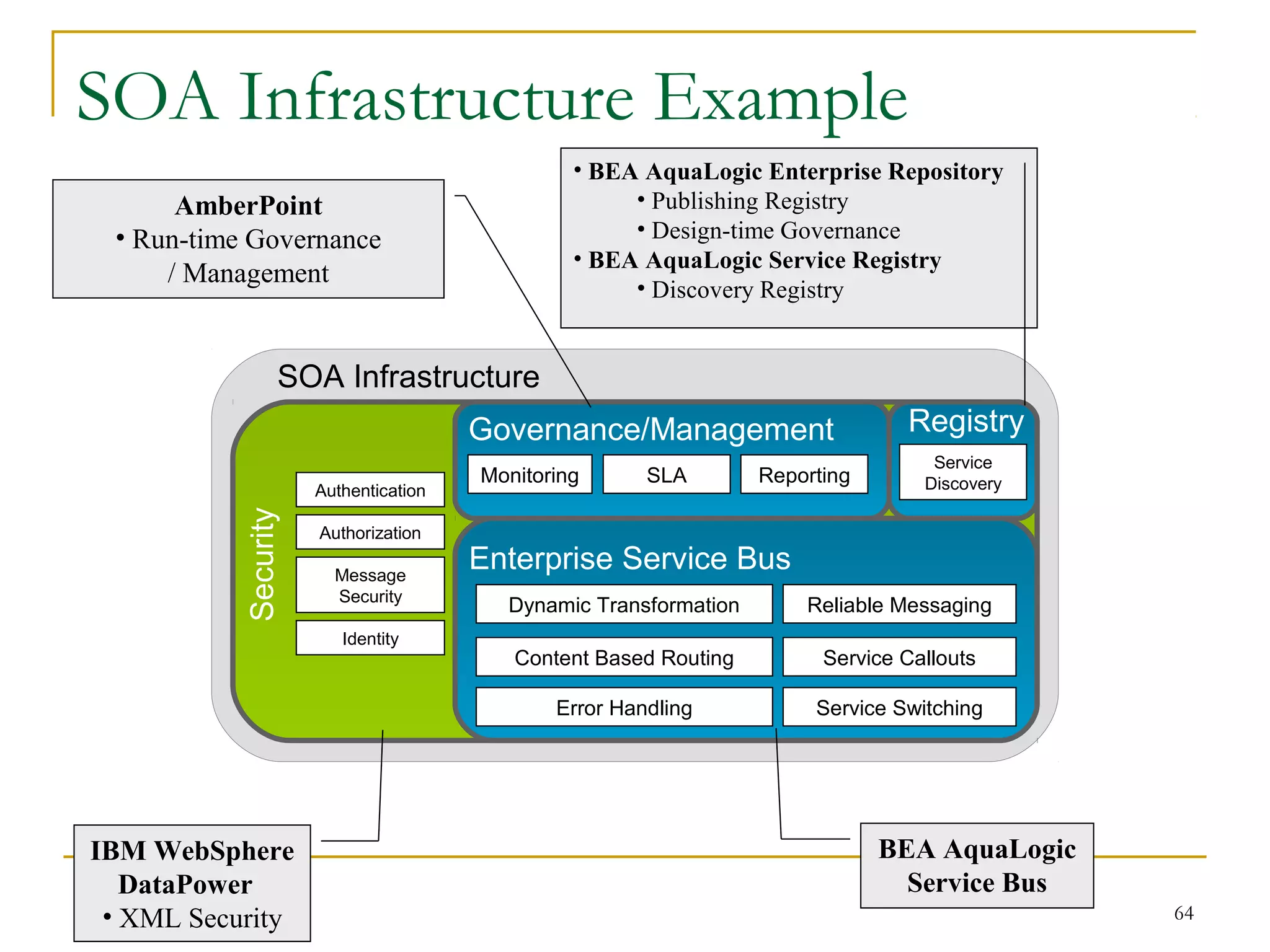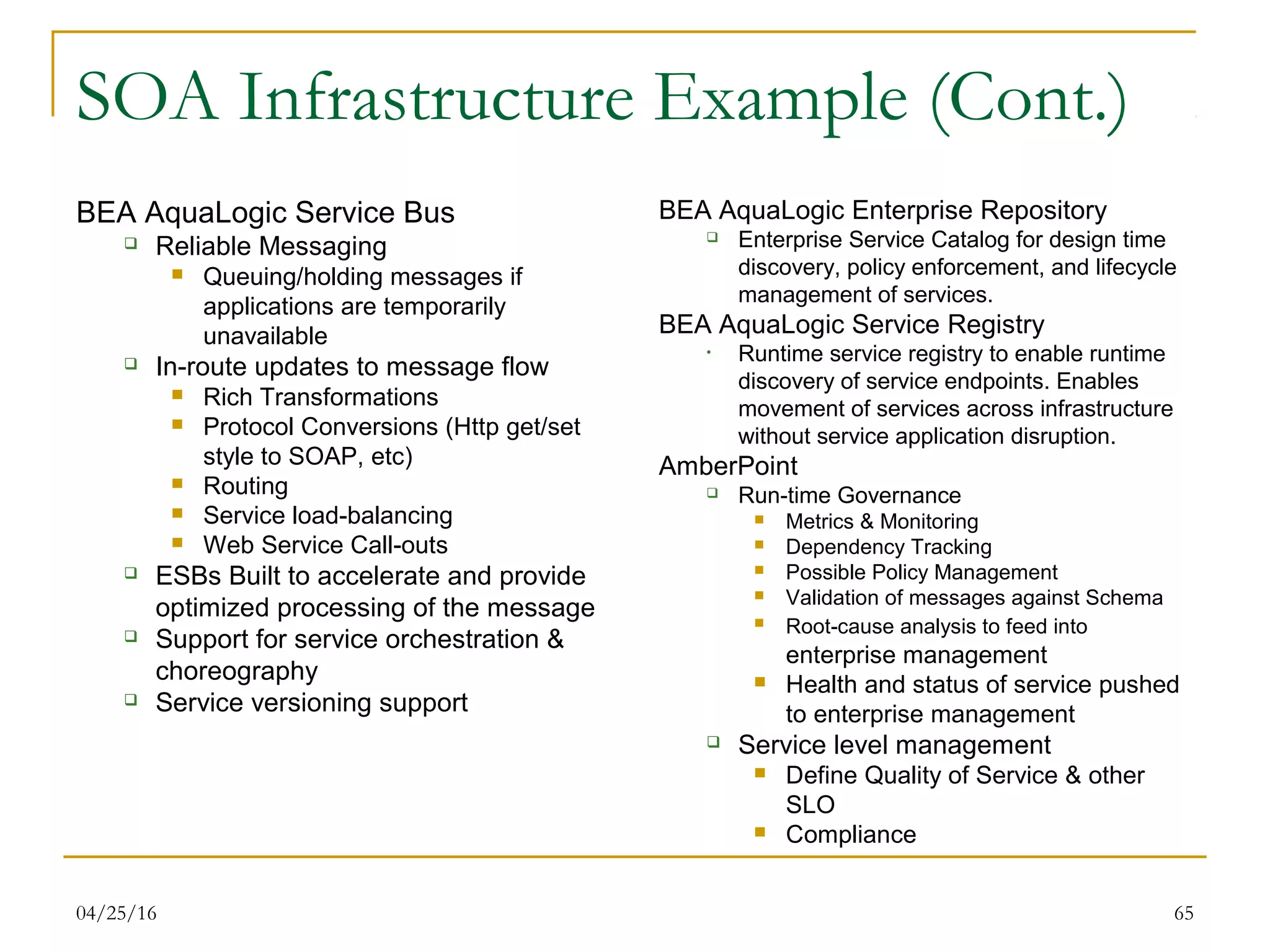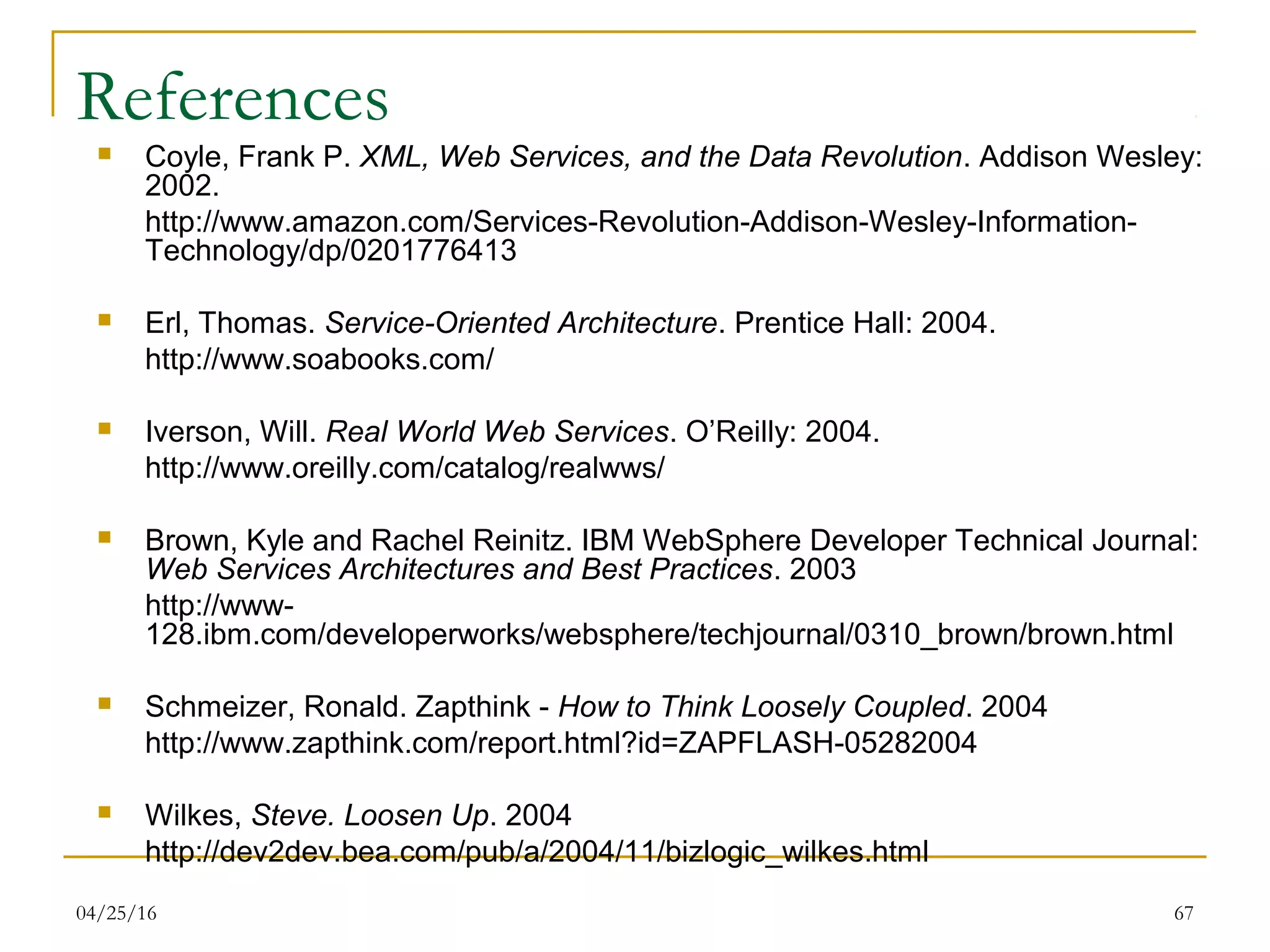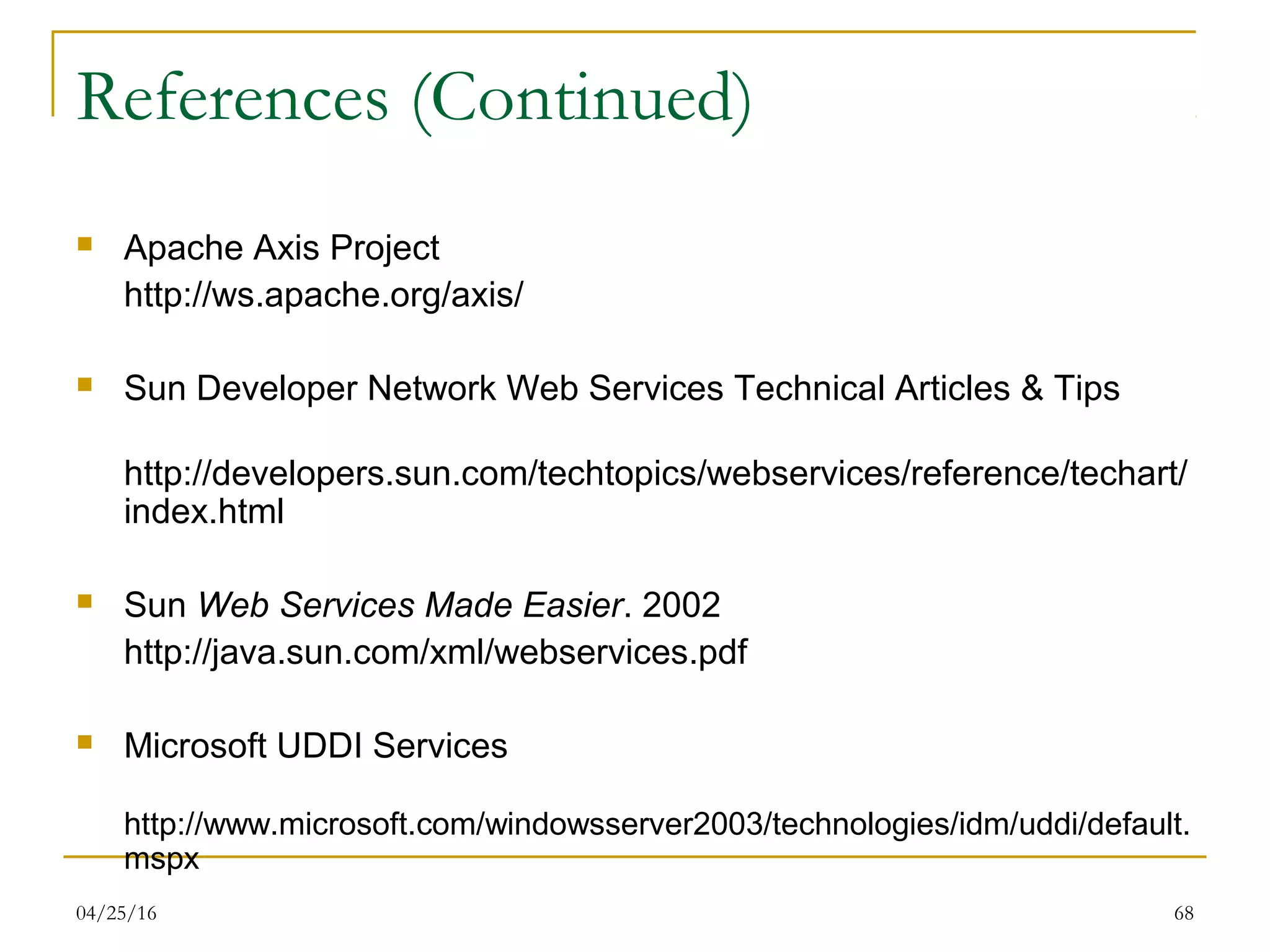This document provides an overview of the history and evolution of XML technologies. It discusses how XML was developed based on SGML and aimed to describe data in a structured format. Key technologies enabled by XML include XML schemas, which define document structure and data types, and transformations languages like XSLT, which allow XML documents to be manipulated. The document also outlines Java APIs that can be used to programmatically work with XML documents and parse XML content.
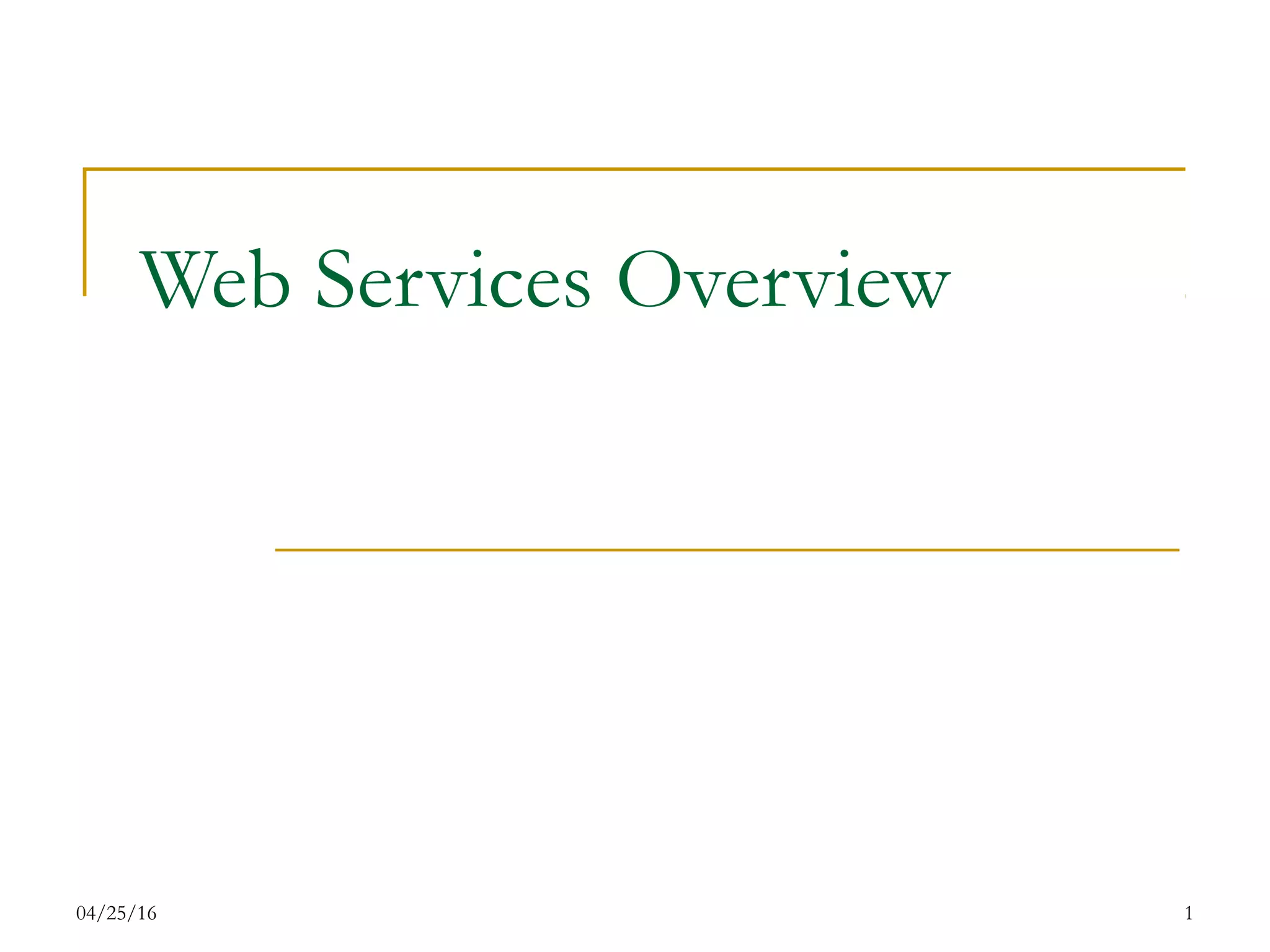
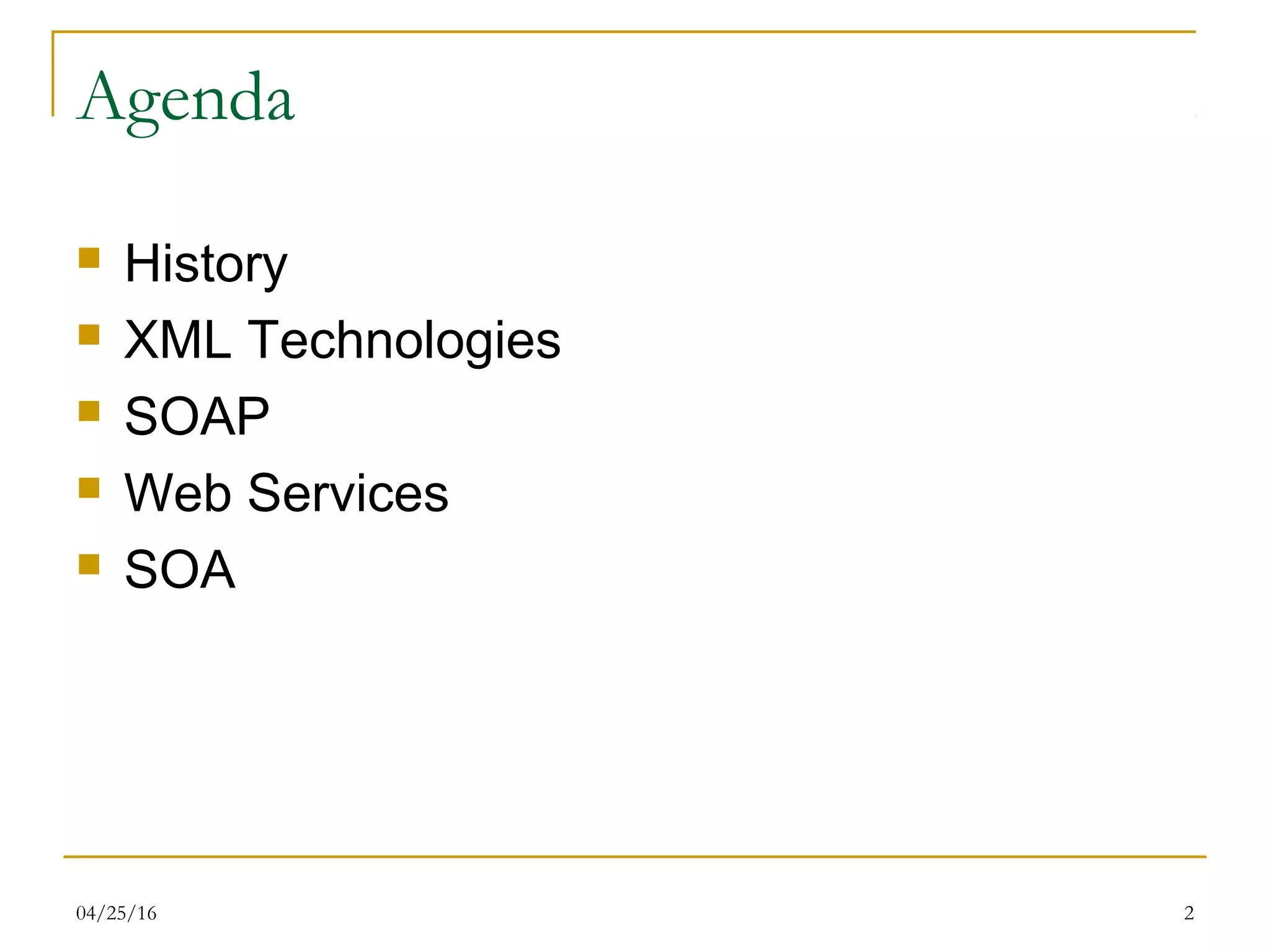
![04/25/16 3
Some History
Mid 1970’s - Standard Generalized Markup Language (SGML) introduced by
Charles Goldfarb
Provides an international standard for data representation
Early 1980’s – Emergence of the Internet leveraging the Internet Protocol suite,
including TCP/IP
http://en.wikipedia.org/wiki/Internet
http://en.wikipedia.org/wiki/Internet_protocol_suite
http://www.ietf.org/
Mid 1980’s – World Wide Web and World Wide Web Consortium (W3C)
conceived and founded by Tim Berners-Lee
Created a formal specification for Hypertext Markup Language (HTML) based on
SGML
Provides a compact and simple syntax to describe the format and layout of text—
standard for Web publishing
First Web Browser, Silversmith, by John Bottoms in 1987 based on SGML
1990’s - W3C created Hypertext Transfer Protocol (HTTP) a method used to
transfer or convey information on the World Wide Web. Its original purpose was
to provide a way to publish and retrieve HTML pages.
Late 1990’s – W3C creates Extensible Markup Language (XML) (again based
on SGML), a meta-language to describe the nature of information
Late 1990’s – Simple Object Access Protocol (SOAP) developed with Microsoft
backing by Dave Winer, Don Box, Bob Atkinson, and Mohsen Al-Ghosein to
provide a basic Web messaging framework--now a W3C maintained
specification
[Wikipedia]](https://image.slidesharecdn.com/webservices1-160425153500/75/Web-services-Overview-in-depth-3-2048.jpg)
![04/25/16 4
Evolution to SOA
[Coyle]
Programming World
Code-centric
development
Data-centric
development
FORTRAN
PL/1
COBOL
Algol
Pascal
AdaVisual
Basic
Basic
IMS
CICS
RDBMS
Object World
OO-Ada
JavaC++
OO-COBOL
C#
C
EJB
COM
CORBA
DCOM SOAP
Component World
Document
World
GML
XML
HTML
SGML
XHTML
TCP/IP
HTTP
Transport /
Protocol
World](https://image.slidesharecdn.com/webservices1-160425153500/75/Web-services-Overview-in-depth-4-2048.jpg)

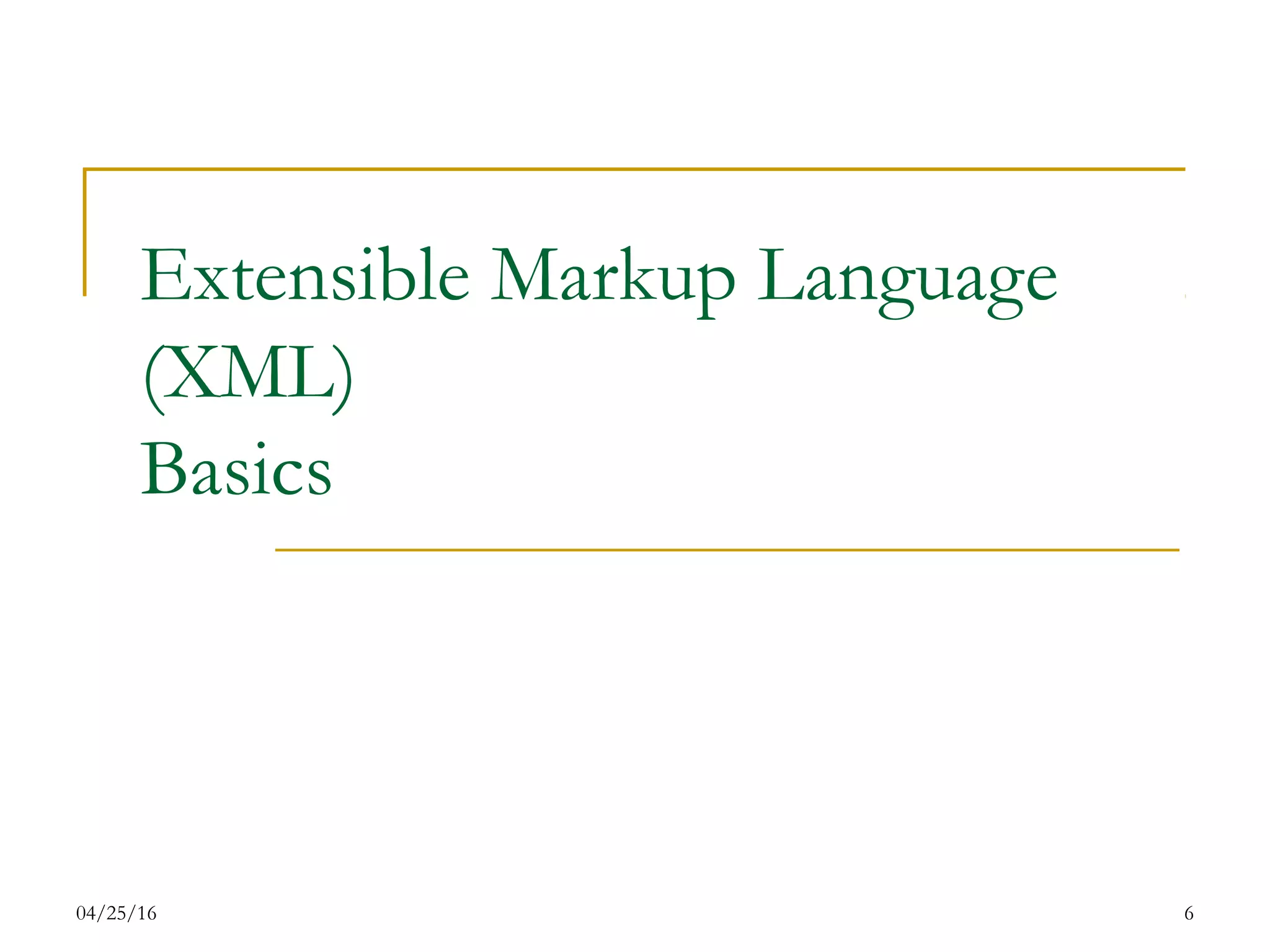
![04/25/16 7
XML Overview
A language for creating other languages
Tags and content, with tags that describe the meaning of content
Start tags and end tags delimit elements containing data
Example of customer information
<Customer>
<Name> John von Neumann</Name>
<PhoneNum>914.631.7722</PhoneNum>
<FaxNum>914.6331.7723></FaxNum>
<E-Mail>Johnny@cd.com</E-Mail>
</Customer>
Data can be specified with attributes within an element
<Customer name=“John von Neumannn” phone=“914.631.7722”
fax=“914.631.7723” email=Johnny@cd.com/>
[Coyle]](https://image.slidesharecdn.com/webservices1-160425153500/75/Web-services-Overview-in-depth-7-2048.jpg)
![04/25/16 8
XML Traits
XML allows data to be stored in either
elements or attributes
Elements and attributes can be named to
give the data meaning
Start tags and end tags define elements that
are the basis for XML tree-structured
representations of documents
Elements can contain text data and/or other
elements
[Coyle]](https://image.slidesharecdn.com/webservices1-160425153500/75/Web-services-Overview-in-depth-8-2048.jpg)
![04/25/16 9
XML Advantages
XML files are textual and human readable versus
binary formats
XML is widely supported by industry tools for
developers, Web browsers, databases, application
environments, and operating systems
http://www.altova.com/products/xmlspy/xml_editor
.html
Major relational databases have the native capability
to store, read, and generate XML data
XML support technologies are available for Web
page display and report generation
[Coyle]](https://image.slidesharecdn.com/webservices1-160425153500/75/Web-services-Overview-in-depth-9-2048.jpg)
![04/25/16 10
XML Decoupling
No presentation format is assumed. Unlike HTML, basic XML
makes no rendering assumptions. Supporting technologies such
as style sheets address this.
No built in data typing is provided. DTDs and XML Schema
provide support for defining the structure and data types
associated with an XML document.
No transport is assumed. XML makes no assumption about how
XML is moved across the Internet.
Thus, XML decouples from:
Presentation
Data formats
Transport protocols
[Coyle]](https://image.slidesharecdn.com/webservices1-160425153500/75/Web-services-Overview-in-depth-10-2048.jpg)
![04/25/16 11
XML Specifications
XML
Documents
DTD
XSD
XQuery
XPath
XSLT
describes
describes
searches
searches
transforms
supersedes
uses
usesuses
uses
[Erl]
XSL
presents](https://image.slidesharecdn.com/webservices1-160425153500/75/Web-services-Overview-in-depth-11-2048.jpg)
![04/25/16 12
XML Technologies
Structure and Data Types
Define how specific XML documents should be structured
Document Type Definition (DTD)
XML Schema Definition Language (XSD)
DTDs flow from the SGML world
Specify what elements and attributes are valid for a particular instance
Limited ability to specify data types
XML Schema is a W3C initiative
More precision that DTDs
XML Presentation Technologies
eXtensible Stylesheet Language (XSL) and XSL Formatting Objects support XML for
various output media
XHTML, a modular XML-conformant replacement for HTML
Cascading Style Sheets (CSS) for controlling display properties of HTML or XML in
Web browsers
XForms for collecting data from Web forms and returning XML
VoiceXML for delivering content to voice-enabled devices
Wireless Markup Language for delivery to wireless devices enabled for Wireless
Application protocol (WAP)
[Coyle]](https://image.slidesharecdn.com/webservices1-160425153500/75/Web-services-Overview-in-depth-12-2048.jpg)
![04/25/16 13
XML Schemas
Two schema definition mechanisms
DTD
XML Schemas
Both define the structure of XML documents
Used to validate the form of specific XML formatted
instances
DTD focuses on structure, element and attribute
definition--data typing is limited to text (Based on
SGML syntax)
XML Schema is a newer W3C standard providing for
structure and detailed data type specification, e.g.
times, Boolean, binary, float, decimal, integer, string,
token, etc.
[Coyle]](https://image.slidesharecdn.com/webservices1-160425153500/75/Web-services-Overview-in-depth-13-2048.jpg)
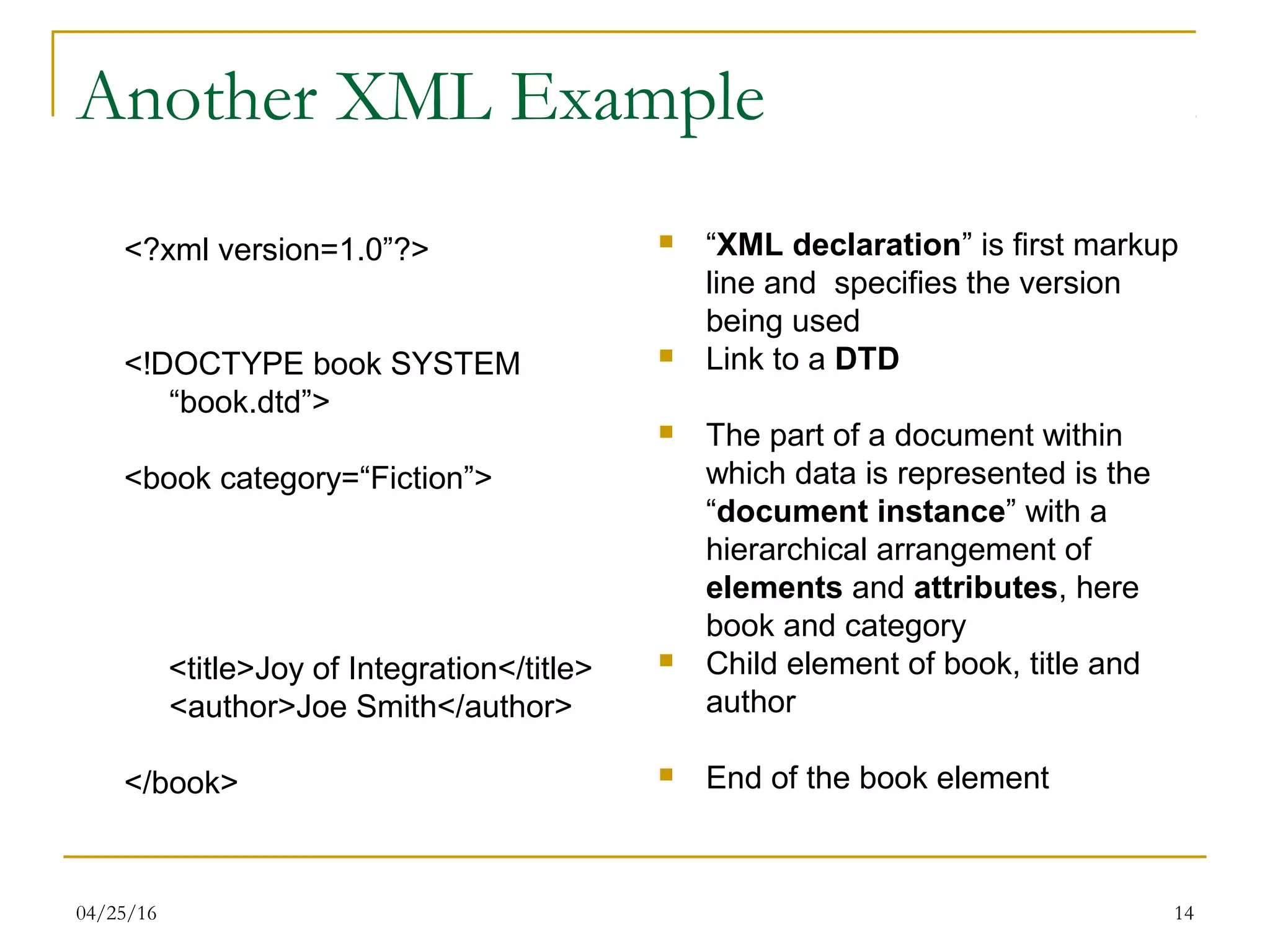
![04/25/16 15
DTD Example
<!DOCTYPE book [
<! ELEMENT book (title, author) >
<!ATTLIST book CATEGORY
(Fiction|Non-Fiction)>
<!ELEMENT title (#PCDATA)>
<!ELEMENT author (#PCDATA)>
]>
Document type declaration of
root element--corresponds to
link in XML document
Characteristics of each
element are specified
Parent-child relationships
Attributes
Validation rules
Data types
Parsed Character Data
Closing](https://image.slidesharecdn.com/webservices1-160425153500/75/Web-services-Overview-in-depth-15-2048.jpg)
![04/25/16 16
Complete Document Specification
DTD
<!DOCTYPE book [
<! ELEMENT book (title, author) >
<!ATTLIST book CATEGORY (Fiction|Non-Fiction)>
<!ELEMENT title (#PCDATA)>
<!ELEMENT author (#PCDATA)>
]>
Instance of the above DTD
<?xml version=1.0”?>
<!DOCTYPE book SYSTEM “book.dtd”>
<book category=“Fiction”>
<title>Joy of Integration</title>
<author>Joe Smith</author>
</book>](https://image.slidesharecdn.com/webservices1-160425153500/75/Web-services-Overview-in-depth-16-2048.jpg)
![04/25/16 17
Namespaces, Element, Attributes
Attributes cannot be further subdivided into sub-
elements, but elements can always be subdivided
Use elements if data may need to be subdivided
Programs processing XML may have to call special
modules to handle attributes introducing complexity
Attributes are more compact and readable
Element and attribute names are distinguished from
the same names in different contexts by prefixing a
Uniform Resource Indicator (URI) as namespace
name. Tagging can be implicit or explicit using
abbreviations
Namespace: http://www.zwiftbooks.com
<book> <title> Deliverance </title> </book>
<http://www.zwiftbooks.com:title>
Namespace: http://www.music.com
<album> <title> Deliverance </title> </album>
<http://www.music.com:title>
[Coyle]](https://image.slidesharecdn.com/webservices1-160425153500/75/Web-services-Overview-in-depth-17-2048.jpg)
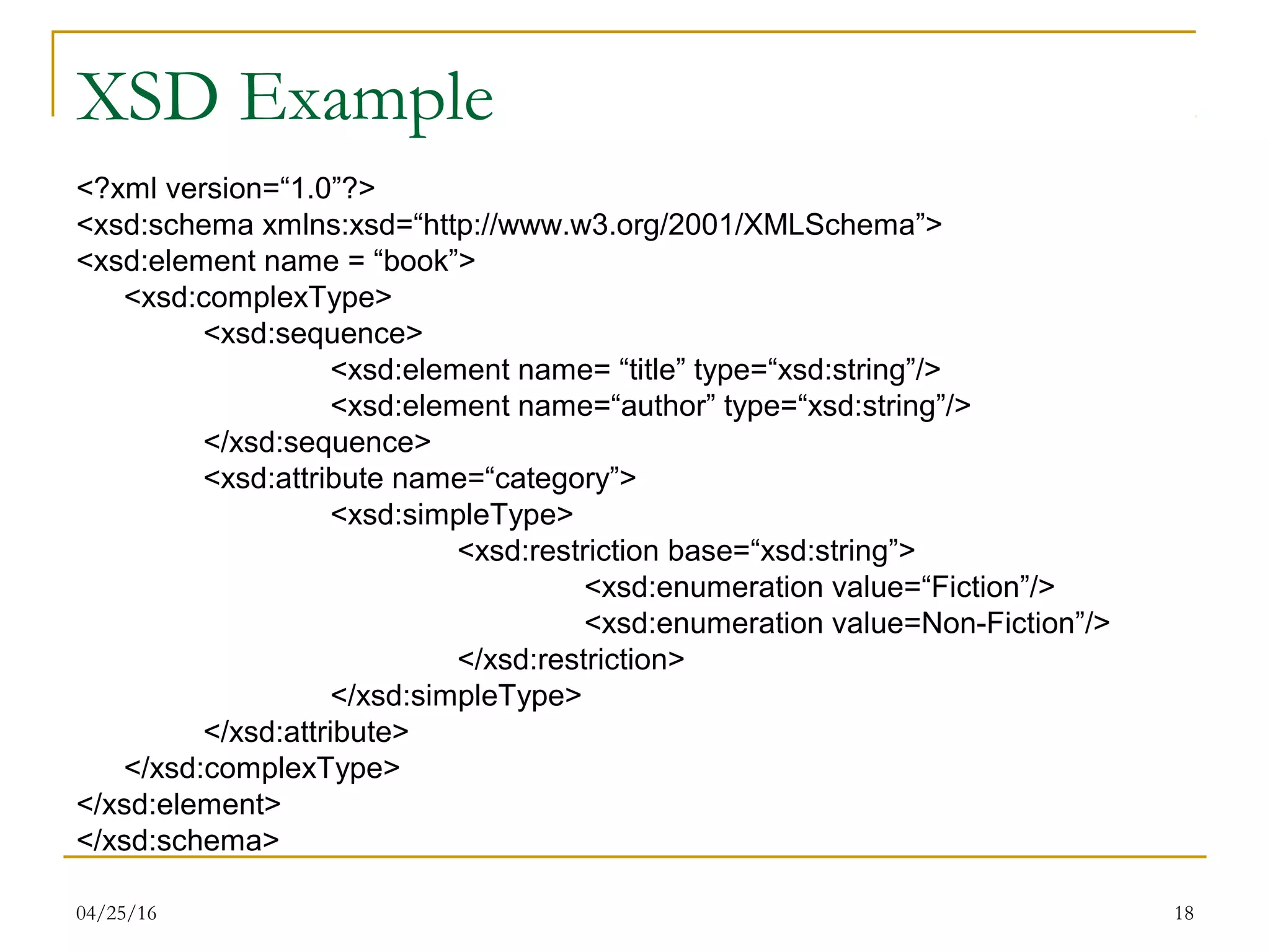
![04/25/16 19
More XML Technologies
DOM
SAX
DTD
XML Schema
RDF
Program manipulation
technologies
Structure & data typing
Semantic Web
XML manipulation
technologies
Presentation
technologies
XSLT
XPath
XLink
XQuery
CSS
XSL
XSL-FO
XHTML
XForms
VoiceXML
XML
&
Namespaces
Core
InfoSet
[Coyle]](https://image.slidesharecdn.com/webservices1-160425153500/75/Web-services-Overview-in-depth-19-2048.jpg)
![04/25/16 20
More XML Technologies
Program Manipulation technologies
Document Object Model (DOM) provides a platform and language neutral interface defined
by W3C that allows programs and scripts to access and update the content, structure, and
style of documents
Simple API for XML (SAX) provides a collaboratively developed standard interface for XML
parsing
Can be manipulated using various interfaces
Tree-based
Event-based
Class-based
XML manipulation technologies
Extract and transform XML in different ways
Key for server-based XML B2B processing
XSL Transformation (XSLT) transforms XML from one format to another
Transform a DOM tree to an XML document
XPath supports navigation through an XML tree structure to find particular elements or subtrees
XLink supports creating and describing links between resources, enabling links that go beyond the
simple uni-directional links of the Web
XQuery supports querying and extracting from XML repositories
Other
Resource Description Framework (RDF) provides a foundation for metadata processing, directed to
automated processing of Web resources
InfoSet is an W3C initiative to provide a consistent set of definitions for use in other specifications
that need to reference information in XML documents.
[Coyle]](https://image.slidesharecdn.com/webservices1-160425153500/75/Web-services-Overview-in-depth-20-2048.jpg)
![04/25/16 21
Java API’s for XML
Document Oriented
Java API for XML Processing (JAXP) – processes XML documents using various
parsers – leverages
SAX (Simple API for XML Parsing)
API for event-based parser
Reads the XML from beginning to end and notifies application for each recognized syntax
construction
DOM (Document Object Model
Interfaces for building an object representation, a tree, of a parsed XML document
Can manipulate tree with insert and remove methods
Random access to particular pieces of data
Java Architecture for XML Binding (MAXB) – maps XML elements to classes in the
Java programming language
Procedure Oriented
Java API for XML Messaging (JAXM) – sends SOAP messages over the Internet in a
standard way
Java API for XML Registries (JAXR) – provides a standard way to access business
registries and share information
Java API for XML based RPC (JAX-RPC) – sends SOAP method calls to remote
parties over the Internet and receives the results
[Sun]](https://image.slidesharecdn.com/webservices1-160425153500/75/Web-services-Overview-in-depth-21-2048.jpg)
![04/25/16 22
SAX API Example
SAXParserFactory factory = SAXParserFactory.newInstance();[Create SAX parser factory]
SAXParser saxParser = factory.newSAXParser(); [Create SAX parser object]
saxParser.parse("priceList.xml", handler); [Parse XML file]
public void startElement(..., String elementName, ...){ [Custom startElement method]
if(elementName.equals("name")){
inName = true;
} else if(elementName.equals("price") && inMochaJava ){
inPrice = true;
inName = false;
}
}
public void characters(char [] buf, int offset, int len) { [Custom characters method]
String s = new String(buf, offset, len);
if (inName && s.equals("Mocha Java")) {
inMochaJava = true;
inName = false;
} else if (inPrice) {
System.out.println("The price of Mocha Java is: " + s);
inMochaJava = false;
inPrice = false;
}
}
}
[Sun]](https://image.slidesharecdn.com/webservices1-160425153500/75/Web-services-Overview-in-depth-22-2048.jpg)
![04/25/16 23
SAX Parsing Example
<priceList> [parser calls startElement]
<coffee> [parser calls startElement]
<name>MochaJava</name> [parser calls startElement, characters,
and endElement]
<price>11.95</price> [parser calls startElement, characters, and
endElement]
</coffee> [parser calls endElement]
...
</priceList>
next invocation of startElement -- inName is true
next invocation of characters -- inMochaJava is true
next invocation of startElement -- inPrice is true
next invocation of characters -- prints price
[Sun]](https://image.slidesharecdn.com/webservices1-160425153500/75/Web-services-Overview-in-depth-23-2048.jpg)
![04/25/16 24
XML To Be Transformed
<?xml version=1.0”?>
<xsl:transform
xmlns:xsl=http://www.w3.org/1999/XSL/Transform
version=“1.0”>
<inventory>
<book category=“Fiction”>
<title>Joy of Integration</title>
<author>Joe Smith</author>
</book>
<book category=“Non-Fiction”>
<title>Integration for Dummies</title>
<author>John Doe</author>
</book>
</inventory>
[Erl]](https://image.slidesharecdn.com/webservices1-160425153500/75/Web-services-Overview-in-depth-24-2048.jpg)
![04/25/16 25
XSLT and XPATH Transformation
<?xml version=1.0”?>
<xsl:transform
xmlns:xsl=http://www.w3.org/1999/XSL/Transform
version=“1.0”>
<xsl:template match=“/”>
<xsl:apply-templates />
</xsl:template>
<xsl:template match=“inventory”/
<table border=“1”>
<xsl:for-each select=“book”>
<tr>
<td><xsl:value-of select=@category”/></td>
<td><xsl:value-of select=“title”/></td>
<td><xsl:value-of select=“author”/></td>
</tr>
</xsl:for-each>
</table>
</xsl:template>
</xsl:transform>
Fiction Joy of Integration Joe Smith
Non-Fiction Integration for Dummies John Doe
[Erl]](https://image.slidesharecdn.com/webservices1-160425153500/75/Web-services-Overview-in-depth-25-2048.jpg)
![04/25/16 26
XML Revolutions
Data revolution – XML
Data is not tied to transport or language – travels using Web protocols
Data previously subordinated to code and transport
Data decoupled from constraints of code and transport
Architecture revolution
Loosely coupled systems centered around the Web and message-oriented
middleware
Previously tightly coupled object systems
Java Remote Method Invocation (RMI)
Microsoft COM/Distributed Component Object (DCOM)
OMG Common Object Request Broker Architecture (CORBA)
Software revolution
Simplicity of design and power of combination and collaboration
Previously large systems built from detailed specifications
Now, assembled systems with capability emergence
[Coyle]](https://image.slidesharecdn.com/webservices1-160425153500/75/Web-services-Overview-in-depth-26-2048.jpg)
![04/25/16 27
Moving Data on the Web
Option 1 – Electronic Data Interchange (EDI)
Defines a common data format
Uses proprietary transport network
Delivers data in agreed upon formats
Option 2 – CORBA, RMI, DCOM
Agrees to a transport protocol supported on multiple platforms
Uses an object request broker to handle inter-object
communication
Delivers data as parameters of method calls
Option 3 – SOAP
Defines an XML envelope for data
Uses common internet protocols to deliver the SOAP envelop
When using HTTP for transport leverages XML data with
attachments
[Coyle]](https://image.slidesharecdn.com/webservices1-160425153500/75/Web-services-Overview-in-depth-27-2048.jpg)
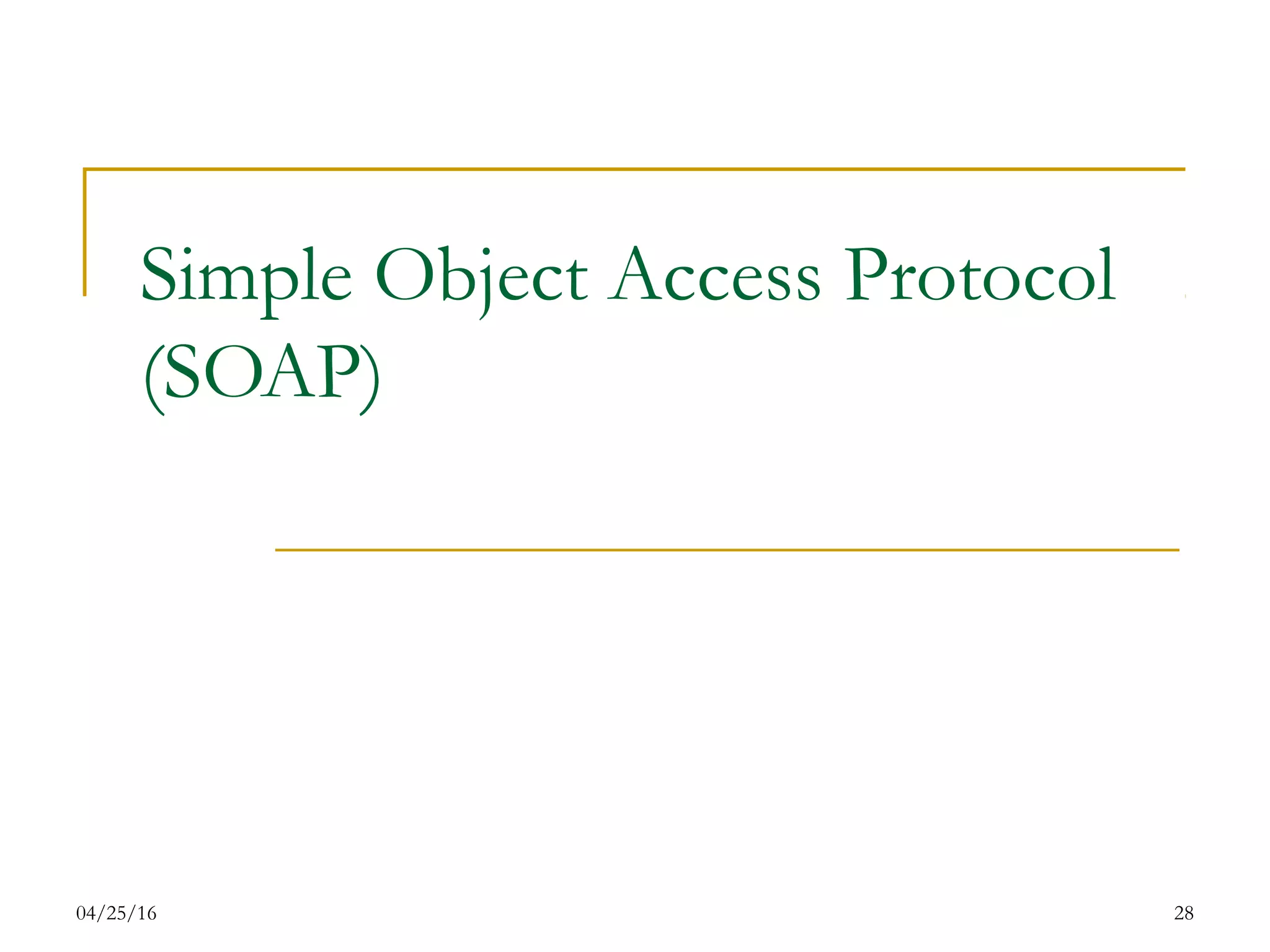
![04/25/16 29
SOAP
Simple – potentially not simple – many possible
options
Object – not particularly related to object-oriented
development – often procedural in nature
Access – ok – one out of four
Protocol – Not a replacement for HTTP or SMTP – it
relies on those protocols to handle the data
http://www.w3.org/2000/xp/Group
[Iverson]](https://image.slidesharecdn.com/webservices1-160425153500/75/Web-services-Overview-in-depth-29-2048.jpg)
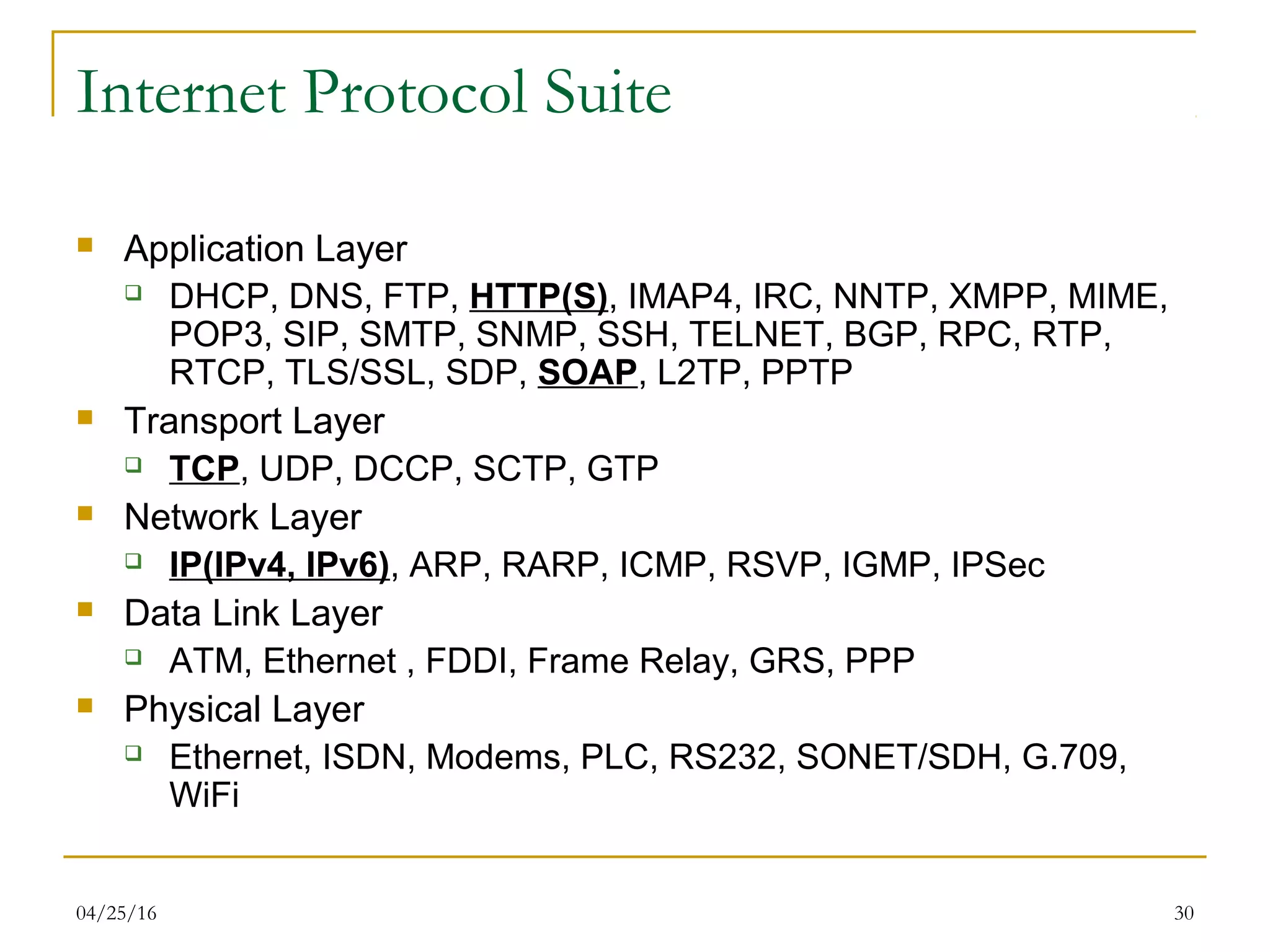
![04/25/16 31
Web Data Transport
HTTP
HeaderData
FTP
HeaderData
HTML document or
browser compatible
type
Any file
Browser
Server Client
GET
POST
GET file.html
HTTP
Web content
returned
HTTP
Web content
returned
Data passed
to server
[Coyle]](https://image.slidesharecdn.com/webservices1-160425153500/75/Web-services-Overview-in-depth-31-2048.jpg)
![04/25/16 32
Power of Combination
SOAP
HTTPXML
Server
Browser
HTML HTTP
SOAPSOAP
SOAP – Combination of HTTP and XML
Web – Combination of HTML, HTTP
and Browsers
[Coyle]](https://image.slidesharecdn.com/webservices1-160425153500/75/Web-services-Overview-in-depth-32-2048.jpg)
![04/25/16 33
SOAP in Context
SOAP is an application layer protocol.
Corba Internet Inter-ORB Protocol (IIOP), Object Remote Procedure
Call (ORPC) (basis for DCOM), and Java Remote Method Protocol
(JRMP) are binary protocols, while SOAP is a text-based protocol
that uses XML
Using XML for data encoding makes SOAP easier to debug and
read.
Since SOAP is text based, it can move more easily across firewalls
than IIOP, ORPC, or JRMP
HTTP based messages pass through port 80 on most firewalls
SOAP is based on XML which is standards driven, versus vendor
driven.
SOAP messages define one-way data transmission; however
messages can be combined to implement patterns such as request-
response
[Coyle]](https://image.slidesharecdn.com/webservices1-160425153500/75/Web-services-Overview-in-depth-33-2048.jpg)
![04/25/16 34
SOAP
Corporate Network
(CORBA, RMI, DCOM)
Loosely coupled Web-based
network using SOAP and
protocols (HTTP, FTP, SMTP)
Tightly coupled network
Based on a common
transport protocol
Message Oriented
Middleware
SOAP
SOAP
SOAP
SOAP
SOAP
XML
SMTPHTTP[Coyle] FTP](https://image.slidesharecdn.com/webservices1-160425153500/75/Web-services-Overview-in-depth-34-2048.jpg)
![04/25/16 35
SOAP Parts
Encoding rules that control XML tags that
define a SOAP message and a framework for
message content
Rules for exchanging application-defined
data types, including when to accept or
discard data or return an exception to the
sender
Conventions for representing remote
procedure calls and responses
[Coyle]](https://image.slidesharecdn.com/webservices1-160425153500/75/Web-services-Overview-in-depth-35-2048.jpg)
![04/25/16 36
SOAP Message Structure
SOAP Envelope – Outermost element of
a SOAP message that is the root of the
XML document defining a SOAP
message
SOAP Header – Optional element that
provides a modular way of directing
SOAP servers to do processing before
passing the message on, e.g. add
transaction or security information or
perform stages of processing in a
message path
SOAP Body – Contains the transported
XML payload which may be data or a
remote procedure call.
SOAP <Envelope>
(Mandatory)
SOAP <Header>
(Optional)
SOAP <Body>
(Mandatory)
[Coyle]](https://image.slidesharecdn.com/webservices1-160425153500/75/Web-services-Overview-in-depth-36-2048.jpg)
![04/25/16 37
SOAP Example Request
Internet
Request
XML Data
HTTP
Header
SOAP Envelope
HTTP
Request
Header
POST/ZwiftBooks HTTP/1.1
Host: www.zwiftbooks.com
Content-Type: text/xml
Content-Length: 134
SOAP Action: “Some-URI”
SOAP
Content
<Envelope>
xmlns: “http:w3.org/2001/09/soap-envelope”
encodingStyle=“http://www.w3.org/2001/09/soap-encoding”>
<Body>
<zwiftbooks: GetBestDeliveryTime
<zwiftbooks:isbn>0-101-22892-3</zwiftbooks:isbn>
<zwiftbooks:zipcode>75230</zwiftbooks:zipcode>
</zwiftbooks:GetBestDeliveryTime>
</Body>
</Envelope>
Client initiating SOAP
request for best book
delivery time
ZwiftBooks server
configured to understand
SOAP
[Coyle]](https://image.slidesharecdn.com/webservices1-160425153500/75/Web-services-Overview-in-depth-37-2048.jpg)
![04/25/16 38
SOAP Example Response
Internet
Response
HTTP
Request
Header
HTTP/1.1 200 OK
Content-Type: text/xml
Content-Length: 122
SOAP
Content
<Envelope>
xmlns: “http:w3.org/2001/09/soap-envelope”
<Body>
<zwiftbooks:GetBestDeliveryTimeResponse
xmlns:zwiftbooks=www.zwiftbooks.com>
<zwiftbooks:Time>8 hours</zwiftbooks:Time>
</zwiftbooks:GetBestDeliveryTimeResponse>
</Body>
</Envelope>
Client initiating SOAP
request for best book
delivery time
ZwiftBooks server
XML Data
HTTP
Header
SOAP Envelope
[Coyle]](https://image.slidesharecdn.com/webservices1-160425153500/75/Web-services-Overview-in-depth-38-2048.jpg)
![04/25/16 39
SOAP Message Paths
SOAP messages may be routed from server to server, supporting
processing at intermediate nodes
Pipe and filter architecture
Layered architecture and multi-tier patterns
Intermediaries can be proxies, caches, store-and-forward nodes, and
gateways
SOAP server rules
Identify the parts of the SOAP message intended for the server
application
Check for actor attribute that is URI of the application or the URI
http://schemas.xmlsoap.org/soap/actor/next which means the application
must process the header
Verify that all parts of the header intended for the application and
associated with a mustUnderstand=“true” attribute are supported,
otherwise fault
Process the parts of header intended for the application
If not the ultimate destination, remove all header elements intended for it
before forwarding the message
[Coyle]](https://image.slidesharecdn.com/webservices1-160425153500/75/Web-services-Overview-in-depth-39-2048.jpg)
![04/25/16 40
Apache Axis SOAP Example
1 import org.apache.axis.client.Call;
2 import org.apache.axis.client.Service;
3 import javax.xml.namespace.QName;
4
5 public class TestClient {
6 public static void main(String [] args) {
7 try {
8 String endpoint =
9 "http://nagoya.apache.org:5049/axis/services/echo";
10
11 Service service = new Service();
12 Call call = (Call) service.createCall();
13
14 call.setTargetEndpointAddress( new java.net.URL(endpoint) );
15 call.setOperationName(new QName("http://soapinterop.org/", "echoString"));
16
17 String ret = (String) call.invoke( new Object[] { "Hello!" } );
18
19 System.out.println("Sent 'Hello!', got '" + ret + "'");
20 } catch (Exception e) {
21 System.err.println(e.toString());
22 }
23 }
24 }
[Apache Axis Project]](https://image.slidesharecdn.com/webservices1-160425153500/75/Web-services-Overview-in-depth-40-2048.jpg)
![04/25/16 41
Apache Axis SOAP Example
Lines 11 and 12 create new Service and Call objects-standard
Java API for XML based RPC (JAX-RPC) objects that store
metadata about the service to invoke
Line 14 sets up endpoint URL-the destination of the SOAP
message
Line 15 defines the operation (method) name of the Web Service
Line 17 invokes the desired service passing a set of parameters
—here just one string
Invoking the program yields the following
% java samples.userguide.example1.TestClient
Sent ‘Hello!’, got “Hello!’
%
[Apache Axis Project, Sun]](https://image.slidesharecdn.com/webservices1-160425153500/75/Web-services-Overview-in-depth-41-2048.jpg)
![04/25/16 42
Apache Axis Example
<?xml version="1.0" encoding="UTF-8"?>
<SOAP-ENV:Envelope
xmlns:xsd=http://www.w3.org/2001/XMLSchema
xmlns:SOAP-ENV="http://schemas.xmlsoap.org/soap/envelope/"
xmlns:xsi="http://www.w3.org/2001/XMLSchema-instance">
<SOAP-ENV:Body>
<ns1:echoString xmlns:ns1="http://soapinterop.org/">
<arg0 xsi:type="xsd:string">Hello!</arg0>
</ns1:echoString>
</SOAP-ENV:Body>
</SOAP-ENV:Envelope>
http://ws.apache.org/axis/java/releases.html
http://mirror.olnevhost.net/pub/apache/ws/axis/1_4
[Apache Axis Project]](https://image.slidesharecdn.com/webservices1-160425153500/75/Web-services-Overview-in-depth-42-2048.jpg)
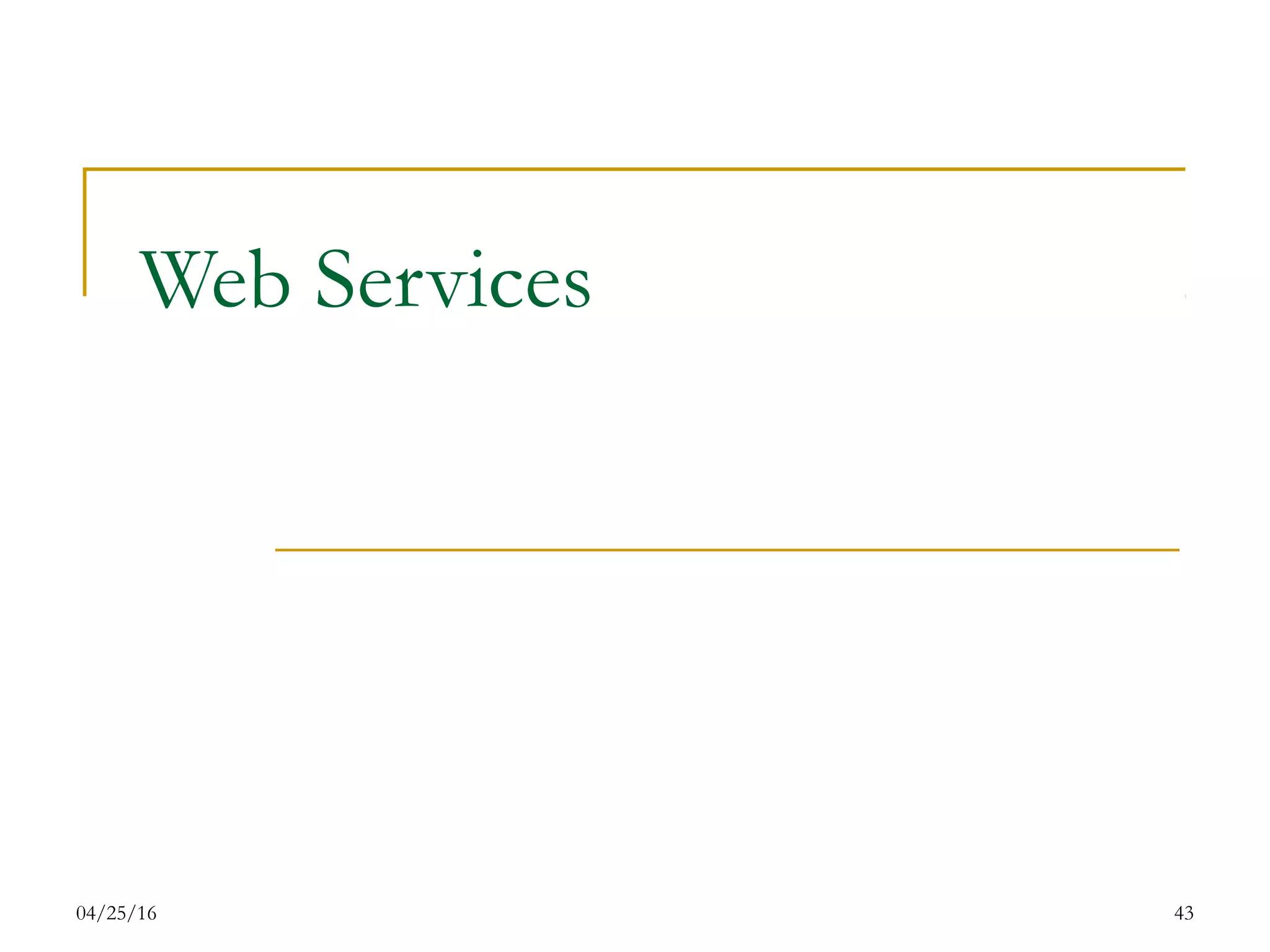
![04/25/16 44
Web Services
A vague term that refers to distributed or virtual
applications or processes that use the Internet to
link activities or software components. A travel Web
site that takes a reservation from a customer, and
then sends a message to a hotel application,
accessed via the Web, to determine if a room is
available, books it, and tells the customer he or she
has a reservation is an example of a Web Services
Application.
Business Process Trends
http://www.bptrends.com/resources_glossary.cfm?
letterFilter=W&displayMode=all
[Iverson]](https://image.slidesharecdn.com/webservices1-160425153500/75/Web-services-Overview-in-depth-44-2048.jpg)
![04/25/16 45
XML Communication
Firewall
Corporate Network
Message
Server
Option 2: Communicate via
messaging middleware
Option 3: Locate partners via Web
services repository – communicate
directly or via messaging middleware
Option 1: Communicate
directly using XML and
Web protocols
XMLXMLXML
Repository
Provider
Client
Web Services
Web
[Coyle]](https://image.slidesharecdn.com/webservices1-160425153500/75/Web-services-Overview-in-depth-45-2048.jpg)
![04/25/16 46
Web Services Again
Technology, process, and phenomenon
As technology, a set of protocols building on
the SOAP, XML, and HTTP foundation
As process, an approach to software
discovery and connection over the Web
As a phenomenon, an industry wide adoption
of a decentralized, loosely coupled,
synergistic approach
[Coyle]](https://image.slidesharecdn.com/webservices1-160425153500/75/Web-services-Overview-in-depth-46-2048.jpg)
![04/25/16 47
Web Services Framework
Describe--Accessible descriptions of functionality and attributes
so other applications can determine how to use it
Expose—Services register in a repository providing
Business information (White pages) holding basic service-
provider information—name, address, telephone number, etc.
Service information (Yellow pages) listing groups of services by
category
Binding information (Green pages) describing how to connect
and use the services—URL’s, method names, argument types,
etc.
Invoke—Remote application can invoke service
Respond—When service is invoked, results are returned to the
requester
Manage/Govern – Provided structure and process control
[Coyle]](https://image.slidesharecdn.com/webservices1-160425153500/75/Web-services-Overview-in-depth-47-2048.jpg)
![04/25/16 48
Web Services Framework
Corporate
Network
Corporate
Network
Firewall
Firewall
Client
Repository
Provider
Web ServicesWeb Services framework provides
Protocols and processes for providers
to register and clients to discover and
use Web Services
XML/SOAP
XML/SOAP
XML/SOAP
XML and SOAP provide an open-ended
data exchange mechanism for the Web
[Coyle]](https://image.slidesharecdn.com/webservices1-160425153500/75/Web-services-Overview-in-depth-48-2048.jpg)
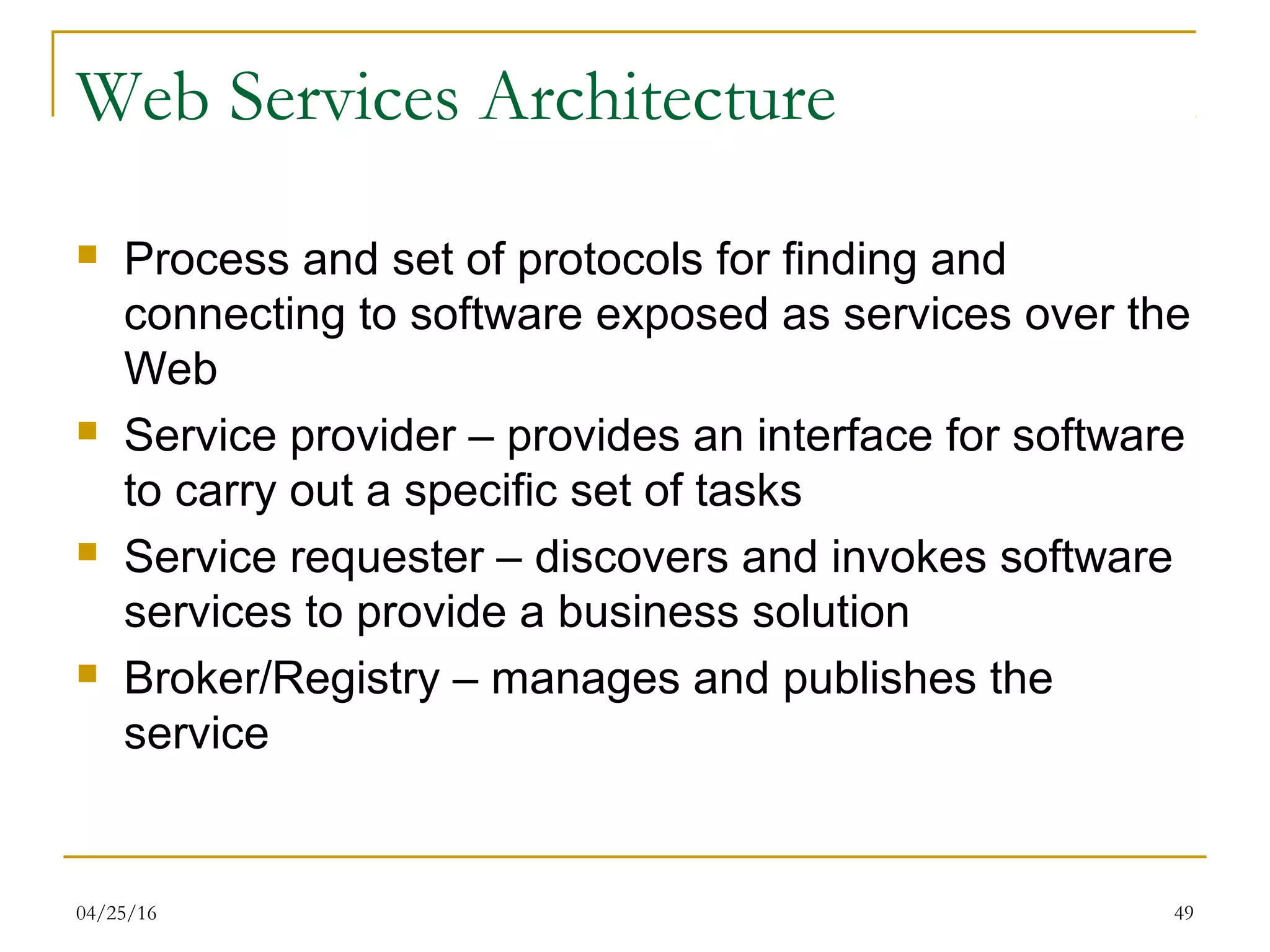
![04/25/16 50
Web Services Triad
Client
Repository/
Registry
Provider
XM
L/SOAP XM
L/SOAP
WSDL
Green
White
Yellow
Uses UDDI to register
a Web Service with the
repository
Uses UDDI to find
appropriate Web
Service
XML/SOAP
WSDL
UDDI
<SOAP:Envelope>
<Soap:Body>
...UDDI Inquiry...
</SOAP:Body>
</SOAP:Envelope> <SOAP:Envelope>
<Soap:Body>
...UDDI Update...
</SOAP:Body>
</SOAP:Envelope>
[Coyle]
UDDI
• Universal Description, Discovery and Integration (UDDI)
• Web Services Description Language (WSDL)](https://image.slidesharecdn.com/webservices1-160425153500/75/Web-services-Overview-in-depth-50-2048.jpg)
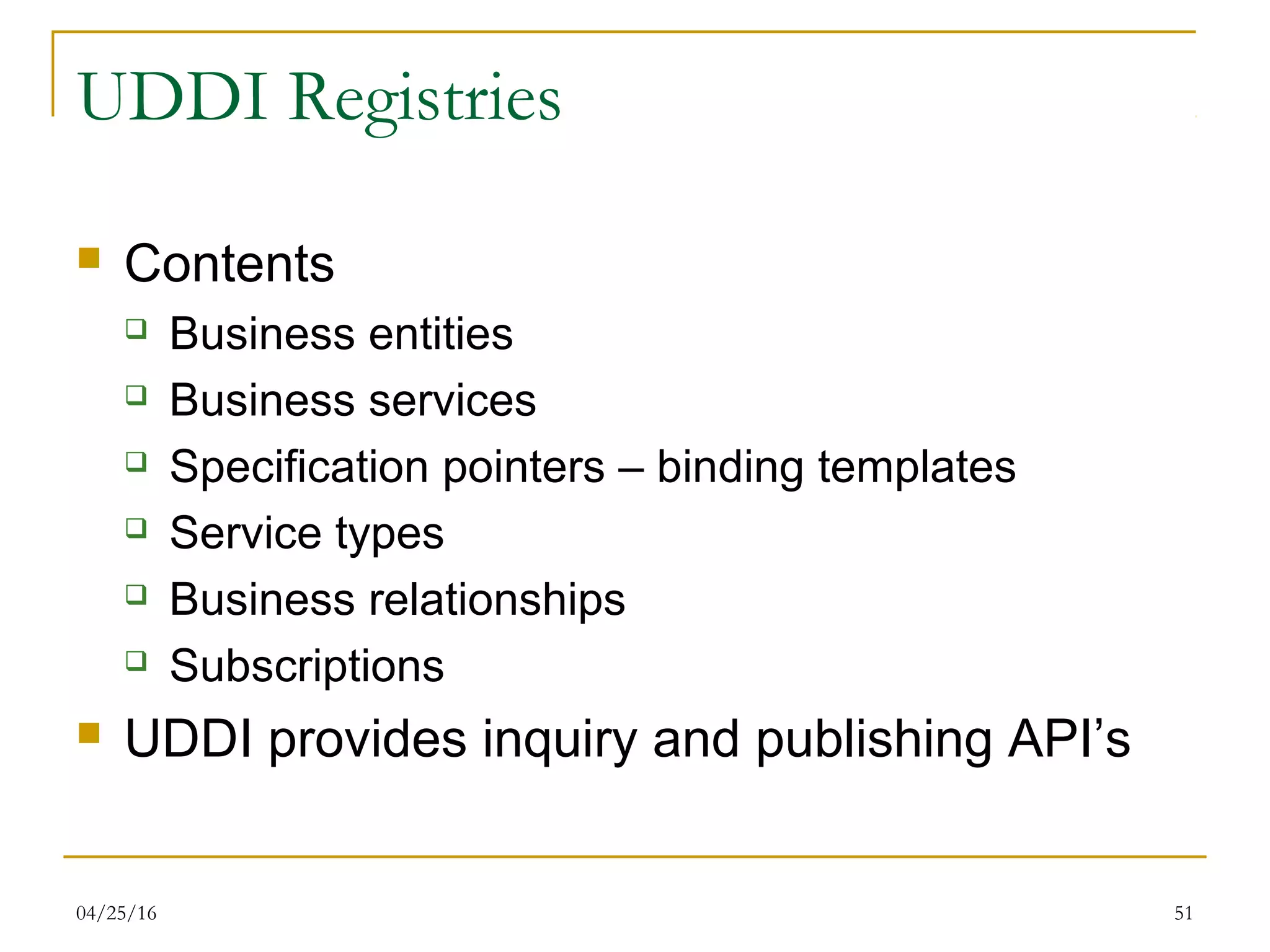
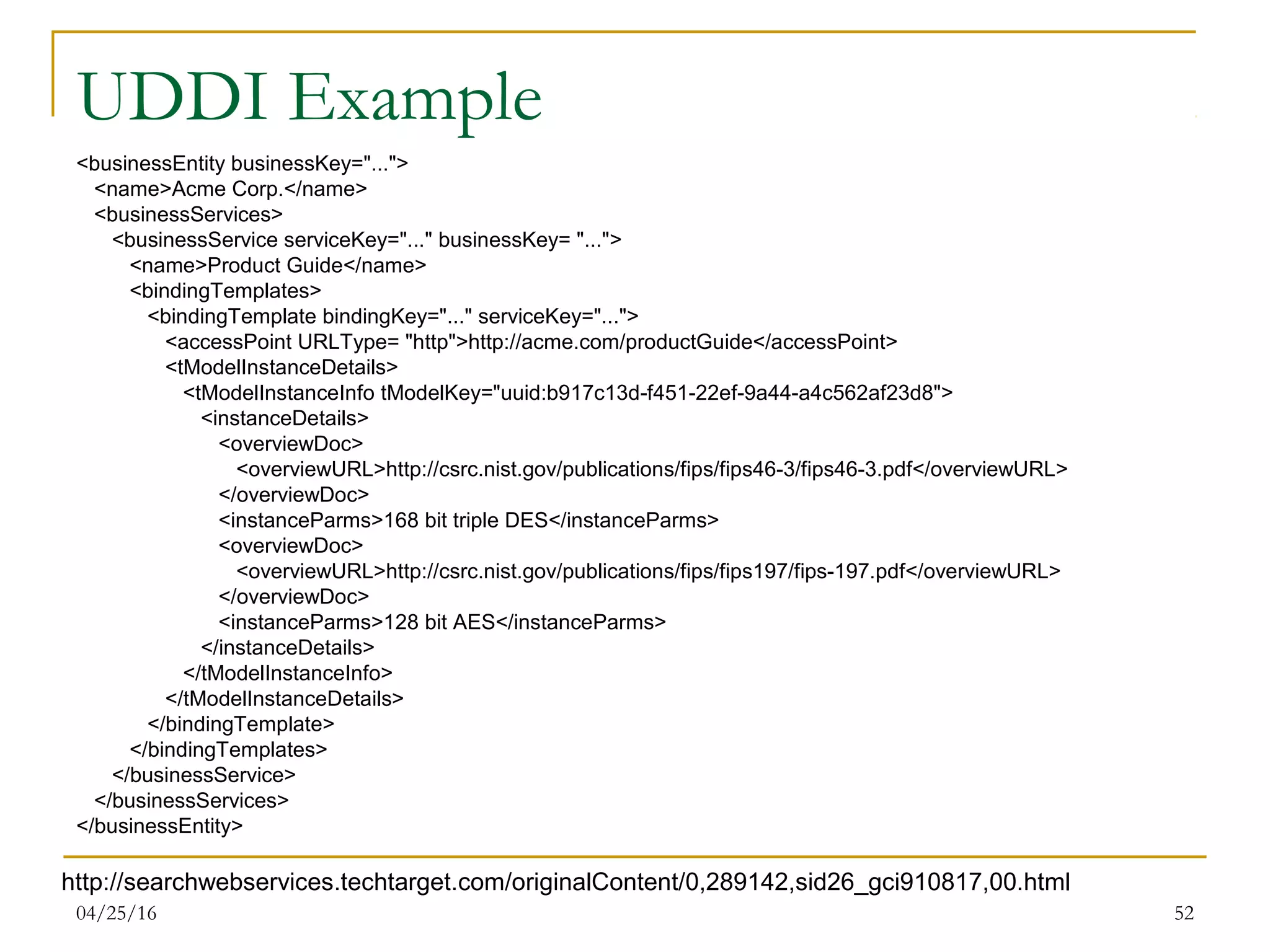
![04/25/16 53
WSDL Document
[Erl]
interface
message
______________
service
binding
endpoint/port
Abstract
(service
interface
definition)
Concrete
(service
implementation
Definition)
Logical grouping of operations
Data description using XML Schema
Actual data structures used to pass data
<definitions>
Service Definition = Abstract + Concrete
Service Description = Service Definition + Supplementary Definitions](https://image.slidesharecdn.com/webservices1-160425153500/75/Web-services-Overview-in-depth-53-2048.jpg)
![04/25/16 54
WSDL Constructs
definitions (root element)
interface (previously
portType) -Group of
logically related operations,
i.e. component interfaces
(methods) representing a
single action or function
message – Collections of
input/output parameters
Part – Incoming or outgoing
operation parameter data
service – Collections of
endpoints including physical
address and protocol info
binding- Association to
operation constructs
<definitions>
<interface name=“Catalog”>
<operation name=“GetBook”>
<input name=“Msg1” message=“BookInfo” />
</operation>
</interface>
<message name=“BookInfo”>
<part name=“title” type=“xs:string”>
Field Guide
</part>
<part name=“author” type=“xs:string”>
Mr. T
</part>
</message>
<service>
<binding name=“Binding1”>
<operation>
<input name=“Msg1” message=“book”/>
</operation>
</binding>
</service>
<types>
<xsd:schema
targetNamespace=http://www.examples.ws/
xmlns=http://www.w3.org/2000/10/XMLSchema>
...
</xsd:schema
</types>
</definitions>
[Erl]
AbstractConcrete](https://image.slidesharecdn.com/webservices1-160425153500/75/Web-services-Overview-in-depth-54-2048.jpg)
![04/25/16 55
Web Services Pros and Cons
Pros
Global method for
describing and finding
Internet–based business
services
Packaging and publishing
of applications in a readily
understood format
New revenue streams
through syndication of
existing application as
Web Service
Cons
Emerging technology
Managing and Tracking
changes is a challenge
Transactions not fully
addressed
Multiple, evolving security
standards
Processing overhead
[Coyle]](https://image.slidesharecdn.com/webservices1-160425153500/75/Web-services-Overview-in-depth-55-2048.jpg)
![04/25/16 56
Enterprise Context
XML/SOAP
XM
L/SOAPXML/SOAP
Messaging
Security Identity
Transactions
.NET J2EE
Broker/Registry
Client
Provider
[Coyle]](https://image.slidesharecdn.com/webservices1-160425153500/75/Web-services-Overview-in-depth-56-2048.jpg)
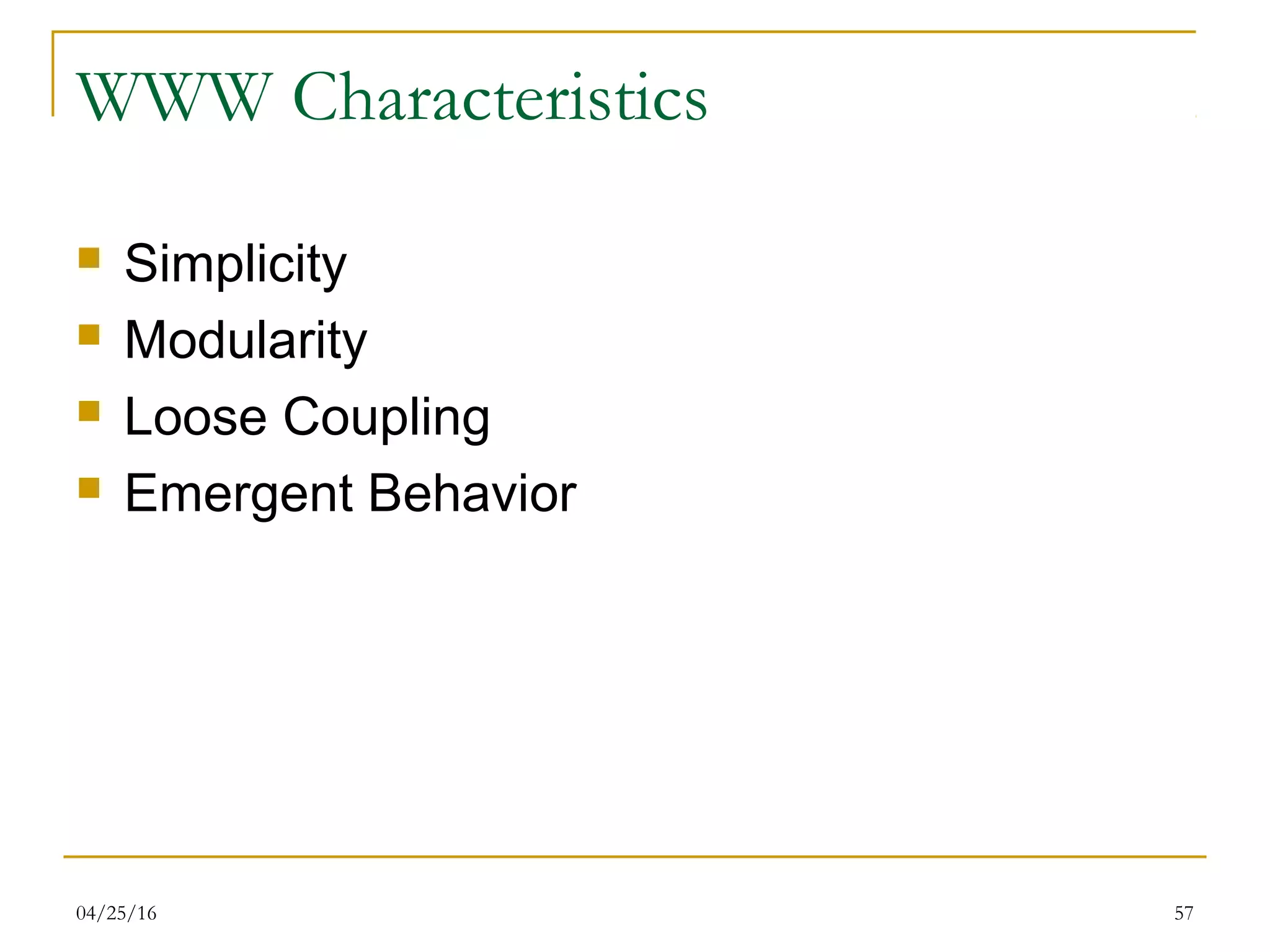
![04/25/16 58
Enterprise Opportunities
Firewall
Corporate Network
Web
B2C
Business to Consumer
B2E
Business to Employees
B2B
Business to Business
[Coyle]](https://image.slidesharecdn.com/webservices1-160425153500/75/Web-services-Overview-in-depth-58-2048.jpg)
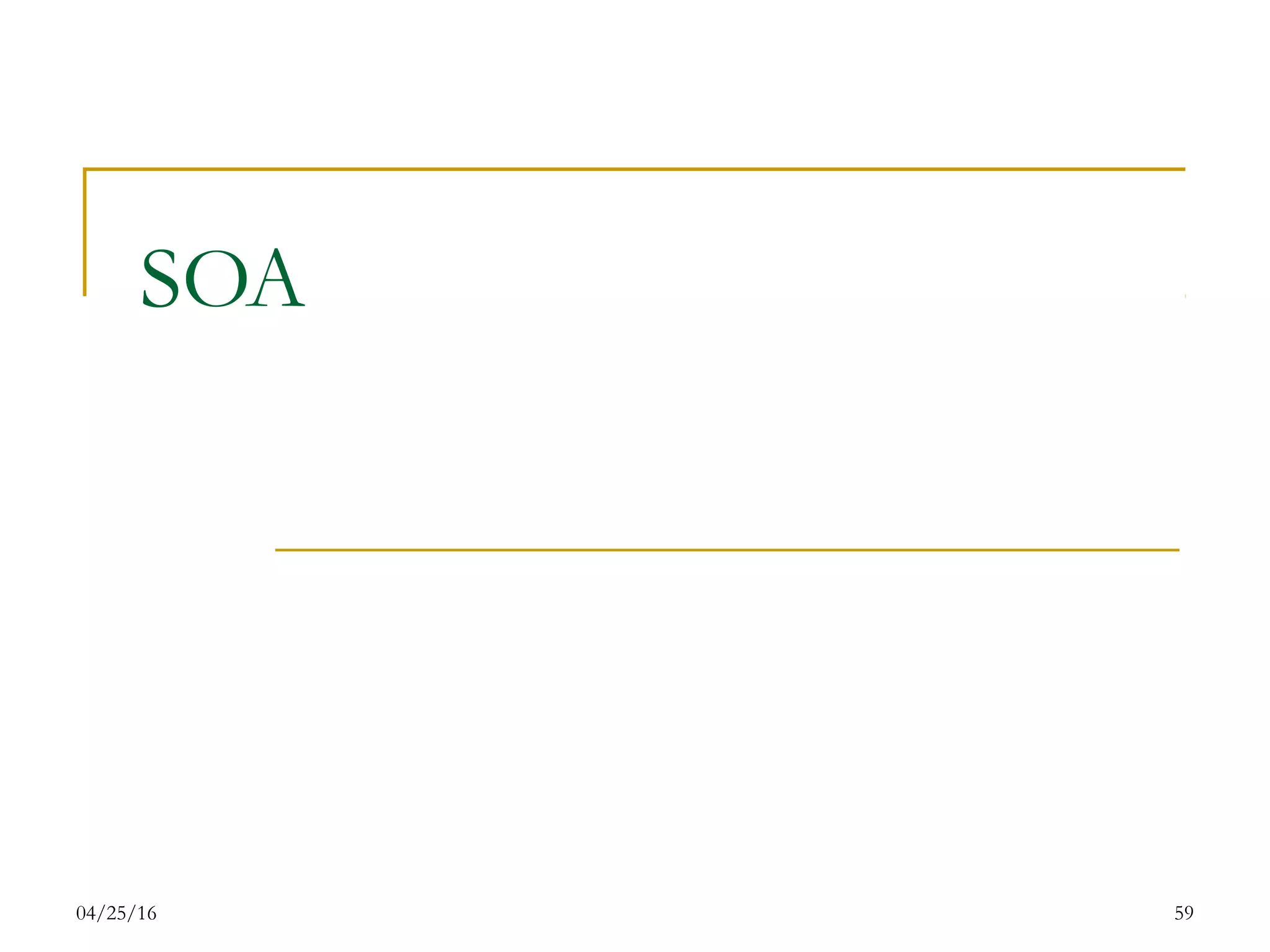
![04/25/16 60
SOA Concept
SOA enables a standards-based marketplace
of service consumers and service providers
across an enterprise community or across
the Web
SOA is a specification-based architecture to
transition the technical landscape to a
standards-based, vendor independent, and
loosely-coupled information sharing
environment
Decoupling the service contract from the service
implementation
Promoting design and invocation by contract
[Government Overview]](https://image.slidesharecdn.com/webservices1-160425153500/75/Web-services-Overview-in-depth-60-2048.jpg)
![04/25/16 61
SOA Conceptual Framework
Management
Governance
Mediation
Service DiscoveryMessagingSecurity
[Government Overview]](https://image.slidesharecdn.com/webservices1-160425153500/75/Web-services-Overview-in-depth-61-2048.jpg)
![04/25/16 62
SOA Common Infrastructure
ManagementGovernanceMediation
Service DiscoveryMessagingSecurity
• How do I discover
services to use?
• How do I advertise my
service to be used by
others?
• How do I guarantee my
message is received?
• How do I send
messages
asynchronously?
• How do I protect
access to my service?
• How do I make my
security requirements
known?
• How do I obtain data
from various data
sources in a format that I
can easily view and
understand?
• How do I ensure interoperability
amongst services?
• How do I ensure that services
are discoverable and able to be
consumed?
• How do I manage SLAs for my
service?
• How do I monitor the use of my
service?
• How do I report QoS metrics
for my service?
[Government Overview]](https://image.slidesharecdn.com/webservices1-160425153500/75/Web-services-Overview-in-depth-62-2048.jpg)
![04/25/16 63
SOA Infrastructure Standards
ManagementGovernanceMediation
Service DiscoveryMessagingSecurity
• UDDI
• ebXML
• WS-Discovery
• WS-RM
• WS-RM policy
• WS-Policy
• WS-Addressing
• WS-Notification
• WSS
• SAML
• XACML
• XML-Signature
• XML-Encryption
• WS-Trust
• WS-Policy
• WS-SecurityPolicy
• XKMS
• XSL
• BPEL
• WS-Policy
• XQuery
• XPath
• WSDM
• WS-Management
[Government Overview]](https://image.slidesharecdn.com/webservices1-160425153500/75/Web-services-Overview-in-depth-63-2048.jpg)
